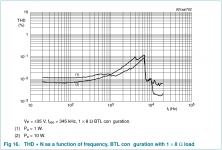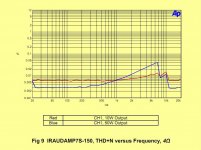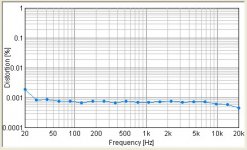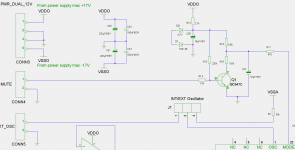...
But I injected a sine wave of 30Hz and I hear a buzzing tone. Unfortunately my scope is broken at the moment, once I got it repaired I will take pictures to show what I hear. For my experience seeing and hearing waves surely I will find the classic distrortion at the zero crossing of the sine wave...
...
Then your implementation is broken. If I inject 30Hz I hear 30Hz and more or less nothing else.
In one of the previous posts I said "would not use for audiophile listening". But for non critical listening, powering a party room, driving subwoofers or as bass guitar amplifier (playing heavy metal music) you may use this chip.
Indeed it may be hard to detect the distortion errors as it is around ~ 0.1% from 4 - 7 kHz but if your speakers are good and your ears are trained you will hear it.
BR, Toni
Attachments
Thank you very much Toni... now I know exactly what's the problem.
I see I was not so wrong thinking that the builder made a mistake and assumes that it is normal behaviour. Anyway, now I have to do it again. This time I will do it myself and do it right!!
Thanks again! 😉
Rei.
I see I was not so wrong thinking that the builder made a mistake and assumes that it is normal behaviour. Anyway, now I have to do it again. This time I will do it myself and do it right!!
Thanks again! 😉
Rei.
Then your implementation is broken. If I inject 30Hz I hear 30Hz and more or less nothing else.
In one of the previous posts I said "would not use for audiophile listening". But for non critical listening, powering a party room, driving subwoofers or as bass guitar amplifier (playing heavy metal music) you may use this chip.
Indeed it may be hard to detect the distortion errors as it is around ~ 0.1% from 4 - 7 kHz but if your speakers are good and your ears are trained you will hear it.
BR, Toni
Is this so much better
Attachments
yes - nearly 20 dB better at small signal level.Is this so much better
yes - nearly 20 dB better at small signal level.
yes but it's 0,01% vs 0,1%. I do hear some artifacts in this region, but for me it's hard to believe that it should be 0,1% distortion in a quite narrow band.
Referenced to what?this is better . NewclassD
THD values above 7khz are meaningless as there are too less harmonics left in the audio band to measure...
IMD results using 19/20k or 13/14k test?
you mean you can hear 0.01% distortion? 😉yes but it's 0,01% vs 0,1%. I do hear some artifacts in this region, but for me it's hard to believe that it should be 0,1% distortion in a quite narrow band.
It is strange as the THD goes a little high at 6kHz or so, that is why I was mot initially worried about it. I know I will be shot down in flames but even with its "high" THD you should not hear anything at those levels.
Does it sound like ringing?
Sent from my iPhone using Tapatalk
Does it sound like ringing?
Sent from my iPhone using Tapatalk
you mean you can hear 0.01% distortion? 😉
No😀 I don't think the artifacts I hear is distortion.
I used nylon screws but should have used metal screws to mount PCB to heatsink, and heatsink should be isolated from metal chassis. I failed on both😱 .I do know I had some oscillation and I think/hope that's the reason for the artifacts. Did some more soldering last night so hopefully I can test within a week or two.
Referenced to what?
THD values above 7khz are meaningless as there are too less harmonics left in the audio band to measure...
IMD results using 19/20k or 13/14k test?
you will have to ask the producer
I FIXED THE PROBLEM OF MY AMP!!!!!!!!!!!!!!!!
Fortunately the chips are not damaged! 🙂
In my next post I will upload a couple of schematics showing the mistake of the builder of the amp and the solution I made!
So chienmort, don't be afraid to make this amp to use with your bass guitar, it will fit perfectly for the task! I will post shots of my bass boxes too, the upper one of the boxes is in my avatar.
Toni, you gave me the most imortant clue to fix the problem with your answer about the 30Hz injection. Thanks! 😉
Fortunately the chips are not damaged! 🙂
In my next post I will upload a couple of schematics showing the mistake of the builder of the amp and the solution I made!
So chienmort, don't be afraid to make this amp to use with your bass guitar, it will fit perfectly for the task! I will post shots of my bass boxes too, the upper one of the boxes is in my avatar.
Toni, you gave me the most imortant clue to fix the problem with your answer about the 30Hz injection. Thanks! 😉
I FIXED THE PROBLEM OF MY AMP!!!!!!!!!!!!!!!!
Fortunately the chips are not damaged! 🙂
In my next post I will upload a couple of schematics showing the mistake of the builder of the amp and the solution I made!
So chienmort, don't be afraid to make this amp to use with your bass guitar, it will fit perfectly for the task! I will post shots of my bass boxes too, the upper one of the boxes is in my avatar.
Toni, you gave me the most imortant clue to fix the problem with your answer about the 30Hz injection. Thanks! 😉
You are welcome!
Thats fine to hear that you got it running. The TDA8950j isn't good enough for audiophile listening, but good enough for every day listening.
BR, Toni
I am pleased that you have repaired your amp. Can you post pictures of the board too please.Fishintowatet
So is the best idea to buy boards and modify them? Alternatively maybe get PCBs made from Toni's Gerber files. Or would Toni sell his amp,ifiers now he is going to SystemD LiteAmp?
So is the best idea to buy boards and modify them? Alternatively maybe get PCBs made from Toni's Gerber files. Or would Toni sell his amp,ifiers now he is going to SystemD LiteAmp?
I'm replacing my tda8950j amp modules with bridged SystemD LiteAmp as I want a relatively high power Class D AMP for 8R Speakers with audiophile quality for my "high end" party room. The TDA8950j project hasn't fullfilled this due to the relatively high distortions at around 4 -7 kHz and the relatively high distortions playing music in the 1 - 5W range.
Of course you can use my Gerber files if you want to diy your pcb @ home as my TDA8950j pcb layout is single sided and therefore very easy to build.
BR, Toni
P.S.: The old amplifier modules may be someday reused for active subwoofers.
I am pleased that you have repaired your amp. Can you post pictures of the board too please.
Thank you!
About the pictures I'm in debt because I didn't take shots of it, but I guess it's better to follow Toni's offer, now I'm building a separate input stage for my amp to avoid rebuilding the entire of it, at least by now, my future plans on this is to make a whole new design.
Rei.
astx: Have you any delay on mute pin? My connex modules produce noise until they have settled (ca 5 seconds). Cristi from connex sugested 100 uF on mutepin to ground, but it does not help. I have tried 480 uF - no luck either.
The mute delay is controlled by a microcontroller and is configured for a delay of 2.5 seconds. There is absolutely no noise or click or pop hearable during mute-phase. Attached a partially schematic showing the mute circuit. The microcontroller is connected at port MUTE and provides TTL level signal.
As you can see I'm using 10µF and a 470R resistor to TDA8950j MODE pin.
The capacitor will be charged/discharged using 5.6k resistor providing a smooth voltage change on mode pin.
BR, Toni
As you can see I'm using 10µF and a 470R resistor to TDA8950j MODE pin.
The capacitor will be charged/discharged using 5.6k resistor providing a smooth voltage change on mode pin.
BR, Toni
Attachments
- Home
- Amplifiers
- Class D
- 4 x BTL 300W/8R - a TDA8950j based 4 channel power amplifier



